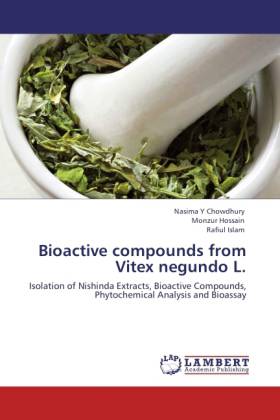
Je cadeautjes zeker op tijd in huis hebben voor de feestdagen? Kom langs in onze winkels en vind het perfecte geschenk!
- Afhalen na 1 uur in een winkel met voorraad
- Gratis thuislevering in België vanaf € 30
- Ruim aanbod met 7 miljoen producten
Je cadeautjes zeker op tijd in huis hebben voor de feestdagen? Kom langs in onze winkels en vind het perfecte geschenk!
- Afhalen na 1 uur in een winkel met voorraad
- Gratis thuislevering in België vanaf € 30
- Ruim aanbod met 7 miljoen producten
Zoeken
Bioactive compounds from Vitex negundo L.
Isolation of Nishinda Extracts, Bioactive Compounds, Phytochemical Analysis and Bioassay
Nasima Y Chowdhury, Monzur Hossain, Rafiul Islam
Paperback | Engels
€ 80,45
+ 160 punten
Omschrijving
Nishinda (Vitex negundo) leaves, stem barks and roots were sequentially extracted with organic solvents Pet spt, EtOAc, acetone and MeOH. Efficacy of these extracts was determined against adult and different larval instars of three strains of T. castaneum using residual film method. The degree of toxicity in the order was leavesstem barksroots. The LD50 values for first through fourth instar larvae were more or less similar whereas, LD50 for fifth instar larva and adults were the lowest. The degree of toxicity according to solvents was MeOHet spt.acetoneEtOAc. The susceptibility order according to insect strains was FSS-IICTC-12KANO. Repellency test using methanolic extract of leaf revealed highly repellent effect on all three strains of T castaneum. Two compounds were isolated and identified using chemical and spectral analysis. The compounds were 22, 23-dihydro alpha-spinasterol-beta-D-glucoside and 2-hydroxy benzoic acid. The spinasterol glucoside showed strong antibacterial property and salicylic acid showed moderate bactericidal as well as strong fungicidal activities. Brine shrimp bioassay showed the toxic effect of these compounds on brine shrimp nauplii.
Specificaties
Betrokkenen
- Auteur(s):
- Uitgeverij:
Inhoud
- Aantal bladzijden:
- 140
- Taal:
- Engels
Eigenschappen
- Productcode (EAN):
- 9783846529447
- Verschijningsdatum:
- 15/10/2011
- Uitvoering:
- Paperback
- Afmetingen:
- 152 mm x 229 mm
- Gewicht:
- 213 g

Alleen bij Standaard Boekhandel
+ 160 punten op je klantenkaart van Standaard Boekhandel
Beoordelingen
We publiceren alleen reviews die voldoen aan de voorwaarden voor reviews. Bekijk onze voorwaarden voor reviews.









